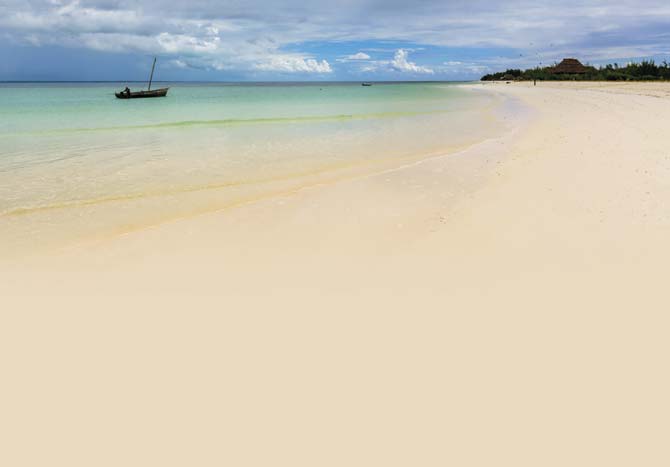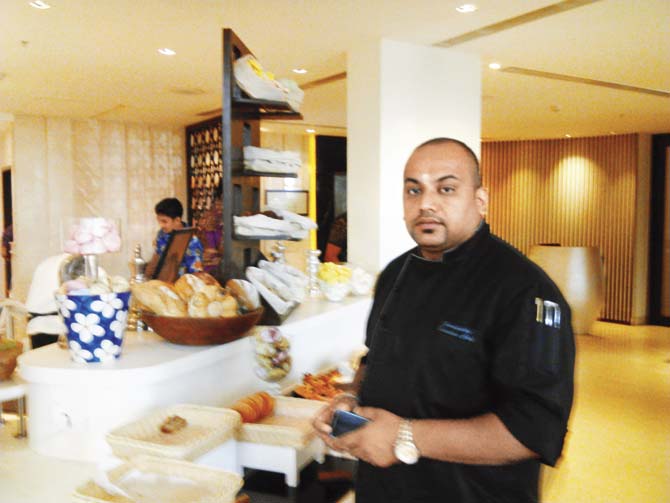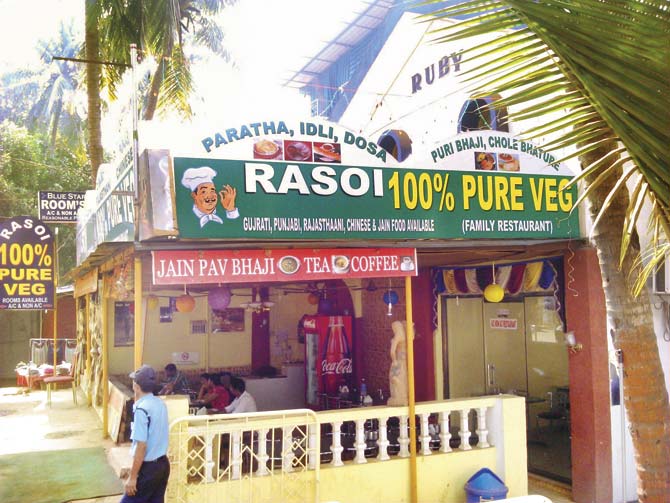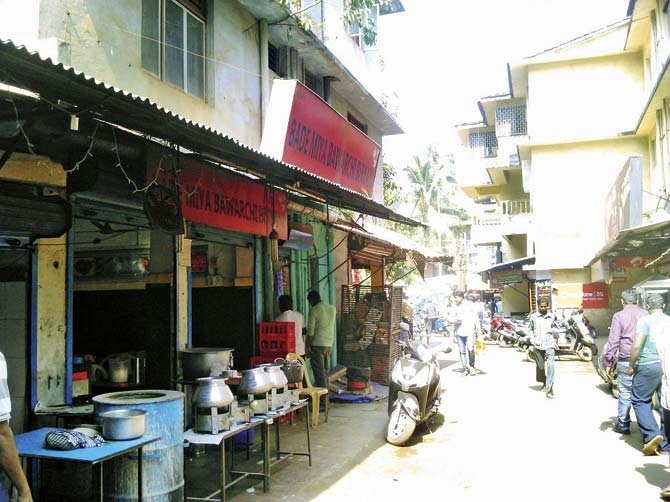Goa has several mini-Mumbais couched in it. From Bollywood, to chaat-style restaurants, the megapolis has muscled its way into Feniland. This development has a darker side to it, too

It had to happen sooner or later. Goa is very high on the list of must-visit places for Mumbaikars and the favourite weekend getaway for its upper crust and Bollywood stars. A large number of them continue to relocate to Goa, so it was but inevitable that small bits and parts of Goa would slowly evolve into mini Mumbais.
ADVERTISEMENT

Nowhere is this more noticeable than in Calangute, a coastal village with the so-called queen of beaches in Goa. It is the busiest tourist destination in Goa. Today, it is almost like Juhu beach, albeit with hundreds of beach shacks and beach beds with svelte foreign women lounging around in bikinis for that holiday tan, and, yes, touts selling and offering everything from roasted peanuts to ‘cutting chai’.

Chef G Mallya
In many cases, they are also offering women. Some of the shacks and resorts too, are named ‘Bollywood’, and instead of serving fish-curry-rice and grilled prawns, they serve up chaats. True to their name, they blare loud Bollywood music.

Change in the palate thanks to assimilation
There are even eunuchs like on Juhu beach harassing tourists, and dozens of bhel puri carts and stalls. The most popular snack at the Calangute beach main entrance is the Mumbai big Mac or vada-pav, just like outside CST.

That’s a different kind of taste in khau galli
Second homes
The number of A-list Mumbaikars owning ‘second’, holiday homes in Goa, from Akshay Kumar and Twinkle Khanna to Alyque Padamsee and Deveika Bhojwani, is also constantly growing, and most of them are somewhere in what is known as the north Goa beach-belt comprising Calangute-Candolim and the surrounding villages.
Apart from the stars, though, there are probably thousands of aam admis from Mumbai who have also made Goa their new home, running small and big hotels and businesses, restaurants, clothes stores, handicraft outlets and generally are enjoying the quality of life, which is undoubtedly better than that in Mumbai.
The booming tourist industry has been a big business opportunity for many from mercantile Mumbai. It takes a while, though, to adapt to the Goan life. “But once you get used to it, you never want to go back to Mumbai,” says Archana V, an advertising executive for a Mumbai-based newspaper who now stays in Porvorim, a new, growing township near Panjim, which is also turning into a mini-Mumbai.
“It is scary at first. The nights in the villages are absolutely quiet, not a sound, and it’s pitch dark everywhere, and you think someone will come out of the darkness at any moment and mug you, but it never happens. Slowly you get used to the leisurely pace of life.”
Cosmopolitan style
Most prefer staying in the northern beach belt because of the wide range of restaurants and shopping options on offer, as also the very cosmopolitan crowd with visitors from all parts of India and the world making it a truly global village.
Somewhere in there are those little mini Mumbais, like the khau galli in Calangute with around a dozen Muslim-style restaurants clustered around the fish market, serving everything from ‘boti kebabs’ to biryanis and kheema, with another couple of dozen-odd Marwari-style namkeen outlets in between.
Jostling alongside the pubs and party spots on Baga road are even more places serving Gujarati thalis and Mumbai-style toasted vegetable sandwiches. Ganpathy Mallya, executive chef at the latest five-star resort to open in Candolim in north Goa, Grand Mercure Goa Shrem Resort, is a Mumbai native.
“Goa always used to be my favourite place and I used to come here at least twice a year,” says the 33-year-old former resident of Dahisar who started his career at the Oberoi, Nariman Point. “I always wanted to retire in Goa, and then I got this opportunity to work in Goa, I just grabbed it.”
In buzz-ness
He agrees that the north Goa beach-belt is getting to be much like Mumbai. “It’s constantly buzzing all year round. It is not like other parts of Goa which still retain that Goa feel,” he says.
He stays bang in the middle of Calangute and when he gets those cravings for Mumbai-style Muslim food, he goes to the khau galli at Calangute market, to Alif’s and tucks into the ‘butter chicken’, ‘chicken tikka masala’, et al.
How would he compare the quality vis-a-vis Mumbai? “Taste-wise it’s okay But they leave your stomach upset,” he quips. Like with the khau gallis in Madanpura and elsewhere, things are not exactly spic ‘n’ span in Calangute’s khau galli. Once in Goa you get to know the places to go to for that special snack or food item.
“But the vegetarian food is terrible in the restaurants here. The ‘New Gujarat’ restaurant in Panjim (on 18th June Road) makes excellent samosas, though,” he says. The owners of this Gujarati eatery are themselves early settlers from Mumbai who found a niche for themselves.
Eat beat
With a large number of domestic tourists being vegetarians and many Jains, too, there are eateries which cater to their special tastes, and there are dozens of places offering ‘Gujarati’ thalis and Jain specialities.
The Muslim eateries in the khau galli around the Calangute market are all owned by former Mumbaikars who have resettled in Goa sensing a business opportunity in the tourism boom or simply because they got some money and bought properties in Goa. Aslam Mohammad, who runs the KGN Biryani Centre, is from Andheri and goes back to his old family home in Mumbai twice a year during the holidays.
And when the Muslims come down for holidays in Goa, they invariably end up in this khau galli where you can have a biryani right from the early hours to late at night when the sigris come out to roast the kebabs. Alif restaurant is hugely popular, while the Bade Miyan outlet opposite is also kept on its toes throughout. There are some more Bade Miyans in Baga, too.
Estate eye
One reason why many from Mumbai end up settling in Goa, at least for a while, is real estate. “There are the people who sell their big Mumbai apartments for a few crores and do not mind investing a crore or two in a place in Goa.
Every year, there are some people who want to get out of Mumbai, to slow down their pace of life,” says Karmal Kukreja, a Bandra boy from Pali Hill who runs a chaat outlet in Baga and is a part-time builder. “And then when they get fed up of the slow life in Goa, they sell the villas at a profit,” he says.
Kukreja built 12 luxury villas in Nagoa, a village neighbouring Calangute, in 2007 and sold them to celebrities like Aftab Shivdasani and Marc Robinson. “There is a demand for luxury villas and apartments in Goa from the rich crowd in Mumbai,” he says.
“Whenever the stock market booms, as it is now, people invest the money they make into second homes, and many love the sea, so they buy properties in Goa.” A big Goa fan himself, Kukreja, a vegetarian, however, would always crave for some ‘flavourful’ pav bhaji or vada-pav and samosa-pav and Elco-style chaat in Goa, and thought that opening a chaat outlet would be a good idea.
So he went right ahead and opened one, ‘La Karira’ on Baga road. “I thought there must be many others like me who crave for a good, flavourful paani-puri or samosa, and I was right. I brought special cooks from Mumbai. When Anupama Verma visited my place and tried the paani-puri, she complimented me, saying,
‘Finally there’s a great place for ‘chaat’ in Goa’.” The unique part of his eatery was that you could get paani-puri even at 2 a.m., Baga being the party hotspot of Goa. Like Mumbai, this place never goes to sleep.
Mumbai flavour
Many of the resorts in the Calangute area are owned or leased by Mumbai-based hoteliers, businessmen and investors, and with most of their clientele from Mumbai, too, the northern beach belt is now practically a micro-Mumbai, albeit without the skyscrapers.
The sprawling ‘Paradise Village Beach Resort’ in Calangute, for example, is owned by the Bandra-based Dandona family, and most of the bookings are done through their Mumbai office. Actor Suniel Shetty is a co-owner in an upcoming five-star resort in Calangute.
The tourism boom has attracted hundreds of different kinds of entrepreneurs into the Candolim-Calangute area, the main hub of tourism in Goa. The nine-km stretch has more than half of all beach shacks and resorts in Goa. While the shacks are officially reserved for local residents, many sub-let them to Mumbaikars who rent them for a ‘season’ (from October to April).
Doing an exact replica of the Mumbai business may not always be a good idea, says Kukreja, citing the example of a Versova pub-nightclub which opened a similar outlet in Calangute, replacing an Irish-style pub, but failed to make an impression.
“In Mumbai, we are used to enclosed nightclubs. In Goa, people like to sit out in the open and enjoy themselves. They thought since they were a well-known party spot in Versova, their Mumbai clients would come to their Goa place too, but it did not happen.”
Beach siblings
There are a couple of other mini-Mumbais elsewhere in Goa, too, the most visible one being at Miramar beach on the outskirts of Panjim. It’s also much like Juhu beach by now with dozens of ‘Bombay bhel puri’, ‘Goa bhel puri’ and ‘pav-bhaji’ carts along a part of the beach front.
Of course, all these little Mumbais have all happened by accident, a creation of circumstances and demand. Many Goan settlers in Mumbai are also returning back to Goa because of new business opportunities, and many bring back a slice of Mumbai to Goa.
Long-time Mumbai resident and musician Colin D’Cruz has also resettled in Goa, close to the beach belt in north Goa and now does jazz music gigs in various nightspots, mostly with Goan musicians who have also resettled in Goa from Mumbai.
“I live in Sangolda in the middle of fields. It is so quiet that I can keep the windows of my studio open while doing recordings,” he says. He flies back to Mumbai one hour by air whenever recordings beckon, and, like in the past in Mumbai, does live jazz music shows at various nightspots.
Serenity season
The real reason why Mumbaikars come to live in Goa is the clean, fresh air, the silence and peace and the greenery all around, and it’s perhaps ironic that the very ingress of the big city people from big, bad Mumbai is changing all that.
Where once there were only open-air dances and full moon beach parties, now there are dozens of pubs and nightclubs which have Bollywood theme nights. And no, not many crave for that Goa of yore. Explaining the reason why all this is happening, Kukreja says, “International tourists will come and go, but Indian tourists will always keep coming, and they want their type of food and stuff. They want their kind of music too.
Most Goans thought I was crazy to start a paani-puri outlet and serve vada-pav, but I knew it would work.” But then his Mumbai cooks got tired of Goa and decided to go back and he had to shut down. He plans to restart though. Yet, the Mumbai infusion in Goa, has its dark side too.
All those bar dancers came into Goa, after they were driven out of Mumbai. Matthew Kurian, head of an NGO El Shaddai which works primarily with orphans says that thousands of these ‘displaced’ women are working in Goa’s seedy, underworld, sex industry most of them in the northern coastal belt, catering to tourists.
Mumbai-style slums have consequently also cropped up in the coastal villages where these women and their pimps stay. It is both sides of a coin some good, some bad, but like it or hate it, it is apparent that Mumbai in Goa, is here to stay.
 Subscribe today by clicking the link and stay updated with the latest news!" Click here!
Subscribe today by clicking the link and stay updated with the latest news!" Click here!






